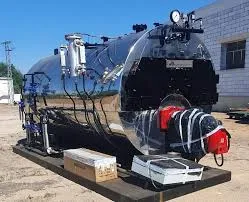
Feb . 16, 2025 06:36 Back to list
biomass fired steam boiler
A dry steam boiler is a critical component in many industrial and commercial operations, providing reliable and efficient steam generation for various applications. Understanding its functionality, benefits, and maintenance can help businesses capitalize on this technology's potential. This article delves into the essential aspects of dry steam boilers, providing valuable insights for decision-makers seeking to enhance their operations.
Trustworthiness should be intrinsic to both the product’s reliability and the supplier’s service. Comprehensive service agreements that cover regular maintenance, emergency support, and parts replacement ensure peace of mind for operators. Testimonials and case studies from other industries can provide further assurance. Companies should also consider third-party certifications that attest to a manufacturer's adherence to safety and quality standards. ISO certifications, for instance, are indicative of a commitment to maintaining high standards in production and service. Experience from peers can also offer invaluable insights into dry steam boiler operations. Networking with industry professionals at trade shows, conferences, and seminars can provide first-hand accounts of the challenges and solutions encountered with these systems. Such interactions often uncover practical tips that can be directly applied to enhance boiler performance or troubleshoot common issues. Peer reviews and industry publications can also serve as reliable resources for those new to dry steam technology. Investing in energy-efficient technology like dry steam boilers not only boosts operational capabilities but also supports broader sustainability goals. As industries increasingly seek to minimize their carbon footprint and adhere to stringent emissions standards, dry steam boilers offer an effective pathway. The synergy between reduced environmental impact and economic benefits makes them a strategic choice for forward-thinking businesses. Future advancements are likely to focus on enhancing automation and energy recovery systems, promising even greater efficiencies. In conclusion, dry steam boilers represent a strategic asset for businesses aiming to achieve high operational efficiency, cost-effectiveness, and sustainability. By focusing on experience, expertise, authoritativeness, and trustworthiness, companies can make informed decisions about integrating this technology into their operations. Selecting the right system and partner not only ensures reliable steam generation but also positions companies to meet future challenges and opportunities in an ever-evolving industrial landscape.


Trustworthiness should be intrinsic to both the product’s reliability and the supplier’s service. Comprehensive service agreements that cover regular maintenance, emergency support, and parts replacement ensure peace of mind for operators. Testimonials and case studies from other industries can provide further assurance. Companies should also consider third-party certifications that attest to a manufacturer's adherence to safety and quality standards. ISO certifications, for instance, are indicative of a commitment to maintaining high standards in production and service. Experience from peers can also offer invaluable insights into dry steam boiler operations. Networking with industry professionals at trade shows, conferences, and seminars can provide first-hand accounts of the challenges and solutions encountered with these systems. Such interactions often uncover practical tips that can be directly applied to enhance boiler performance or troubleshoot common issues. Peer reviews and industry publications can also serve as reliable resources for those new to dry steam technology. Investing in energy-efficient technology like dry steam boilers not only boosts operational capabilities but also supports broader sustainability goals. As industries increasingly seek to minimize their carbon footprint and adhere to stringent emissions standards, dry steam boilers offer an effective pathway. The synergy between reduced environmental impact and economic benefits makes them a strategic choice for forward-thinking businesses. Future advancements are likely to focus on enhancing automation and energy recovery systems, promising even greater efficiencies. In conclusion, dry steam boilers represent a strategic asset for businesses aiming to achieve high operational efficiency, cost-effectiveness, and sustainability. By focusing on experience, expertise, authoritativeness, and trustworthiness, companies can make informed decisions about integrating this technology into their operations. Selecting the right system and partner not only ensures reliable steam generation but also positions companies to meet future challenges and opportunities in an ever-evolving industrial landscape.
Share
Latest News
-
High-Efficiency Commercial Oil Fired Steam Boiler for Industry
NewsJul.30,2025
-
High-Efficiency Biomass Fired Thermal Oil Boiler Solutions
NewsJul.30,2025
-
High Efficiency Gas Fired Thermal Oil Boiler for Industrial Heating
NewsJul.29,2025
-
High-Efficiency Gas Fired Hot Water Boiler for Sale – Reliable & Affordable
NewsJul.29,2025
-
High Efficiency Biomass Fired Hot Water Boiler for Industrial and Commercial Use
NewsJul.29,2025
-
High-Efficiency Biomass Fired Hot Water Boiler for Industrial Use
NewsJul.28,2025
Related PRODUCTS
Copyright © 2025 HEBEI HONGZE BOILER MANUFACTURING CO., LTD. All Rights Reserved. Sitemap | Privacy Policy






















